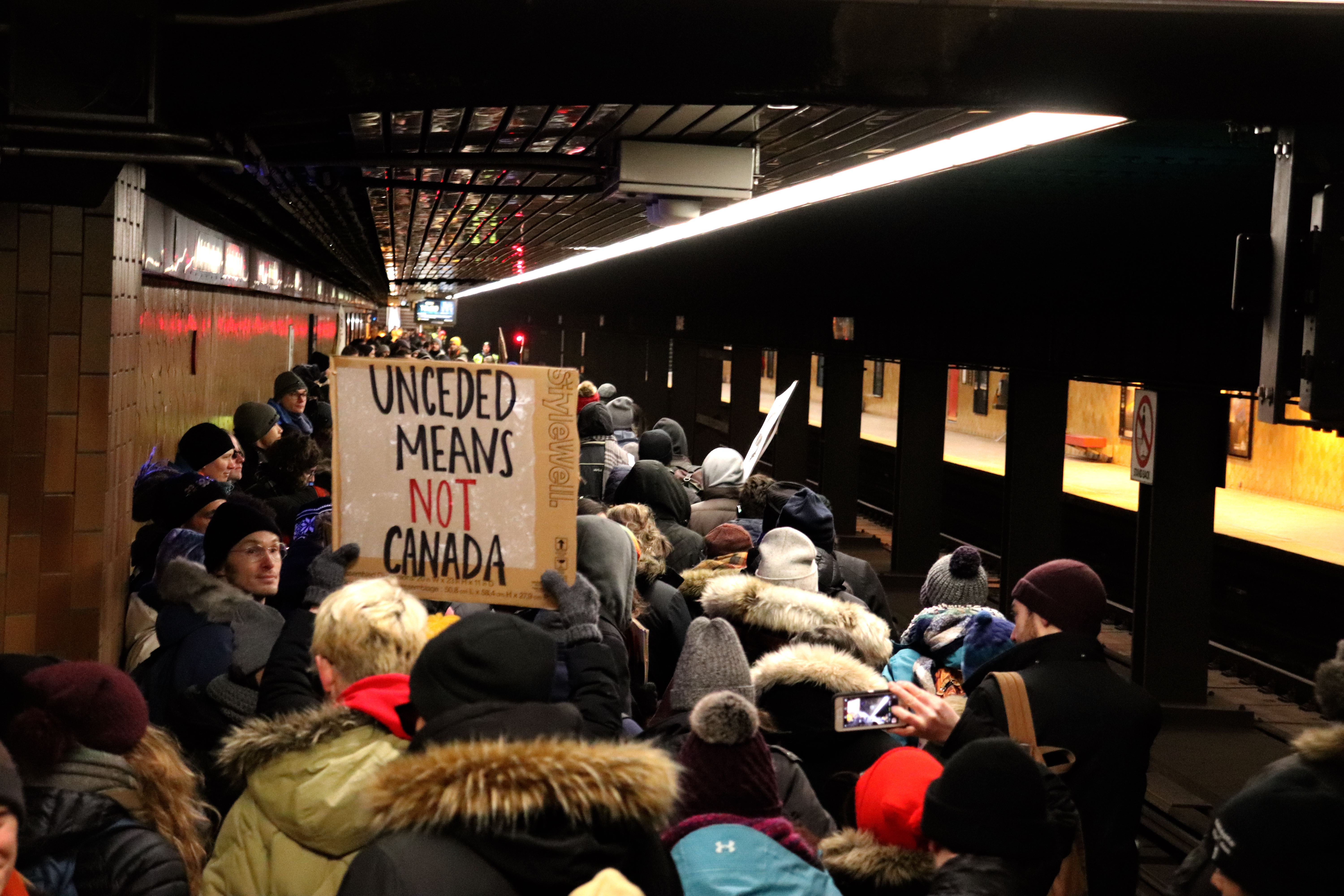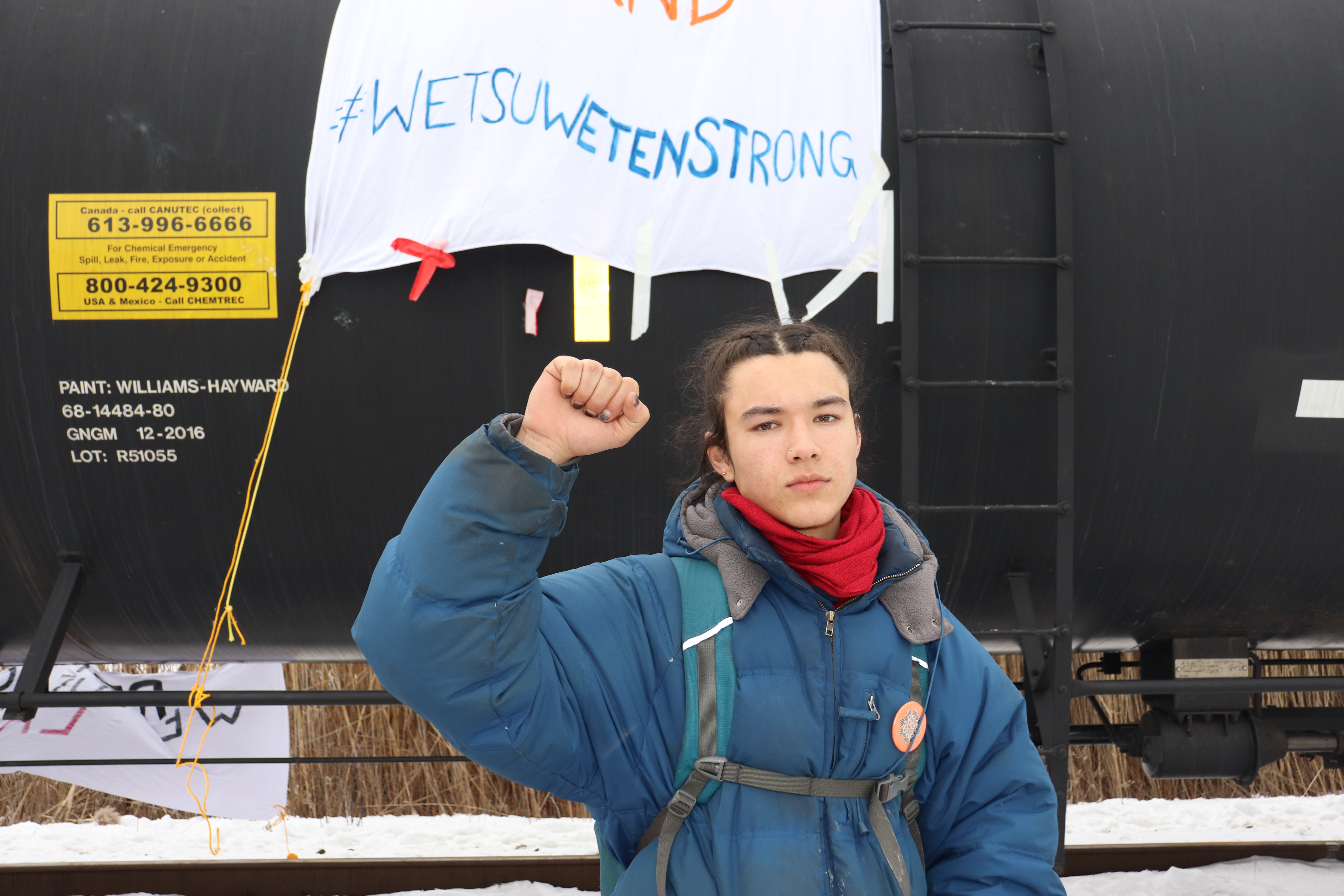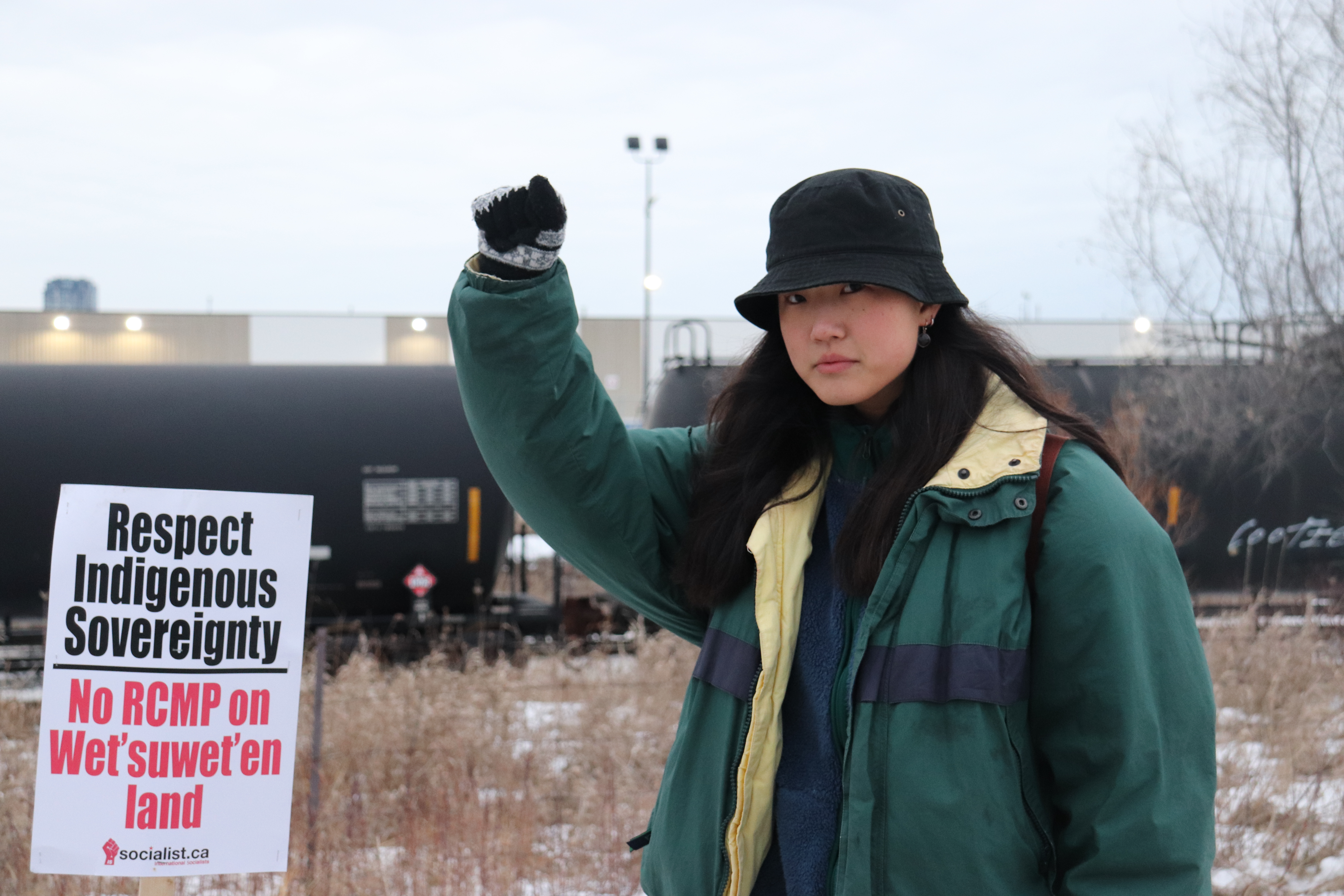This article originally appeared on VICE Canada.
Last Saturday about 200 people marched out of Toronto’s Pioneer Village subway station into the brisk winter air. Around 10:30 a.m. they reached McMillan Yard, Canada’s second-biggest rail yard, where a dozen or so Wet’suwet’en solidarity organizers had already started blockading the rail lines, passenger and freight, going out of Toronto to Hamilton, London, New York, and Michigan.
Those blocking the rail lines quickly made themselves comfortable: On the tracks, folks warmed themselves by a fire contained in a steel barrel, listened to land defenders drum and sing, danced, and shared pizza, tea, and Timbits. One person peeled off their second layer of warm socks to give to a fellow demonstrator whose feet were drenched from melting snow.
To get on the tracks, people climbed in and out of an icy trench, and squeezed through the narrow space between train cars. As people inevitably slipped, others frequently stepped in, sometimes forming a human chain to help them up. Marshals, mostly settler allies who were designated to guide and provide hand warmers and other support to the crowd, could be found on either side of the tracks, lending a hand to whomever might be struggling.
Police cars were stationed on both sides of the tracks, slowly growing in number throughout the day.
By 1 p.m., thanks to a public call for support that spread quickly through social media, the group had almost doubled in size to about 350. It was a diverse and somewhat eclectic crowd that included people from Ontario Public Service Employees Union and animal rights organizations.
Like for other solidarity actions in Toronto, Indigenous peoples did a great deal of the organizing and were visibly leading the march. In the crowd, however, they were a minority. Most of the blockade’s supporters were settlers, both white and racialized. As the movement has grown, so too has the proportion of settlers allying themselves to it.

The group decided to split into two to establish a second blockade that stopped train traffic to Sudbury, North Bay, British Columbia, and Wisconsin. Around 3 p.m., as a police helicopter circled overhead, officers made their way onto the tracks to issue an injunction; it was promptly thrown into the fire, and ignored until around 5:30 p.m. when the group chose to call it a day. On their way out, a handful of the blockaders were pulled over and carded for a traffic stop, though the official purpose of the stops is unknown.
This action was one of dozens like it across Canada over the past two weeks, as Indigenous-led protests have shut down numerous railways following the RCMP’s raid on Wet’suwet’en land defenders earlier this month. The movement is demanding that the RCMP stand down at Unist’ot’en in northern B.C., where police have raided unceded Indigenous territory. Wet’suwet’en Hereditary Chiefs and their many supporters have been blocking the construction of the $6 billion Coastal GasLink pipeline on the land to which they hold the title.
The solidarity movement certainly opposes the pipeline, but it is first and foremost a laser-focused call for Canada to respect Indigenous sovereignty. That priority is enshrined in the movement’s rallying cry: Shut Down Canada.
“We’ll always remember that in our teens, in our 20s, we (Indigenous youth) all grouped up together and declared that reconciliation is dead,” said Cricket Guest, who was sitting on the train tracks. The 20-year-old Anishnaabe Métis land defender led Toronto’s 15,000-person climate march last September, and now she’s one of the many Indigenous youth spearheading the national wave of actions and rallies in solidarity with Wet’suwet’en people.
“Everyone has really come together to show solidarity with Wet’suwet’en,” said Samuel Wong, a 20-year-old Métis Cree land defender from north of Edmonton. “It’s really united all the groups in Toronto, and now we’re building all these amazing relationships… It’s making us collectively a lot stronger.”
Like many others, he joined the movement on his own. He now navigates it with ease, alternating between taking space at the front of the movement and lending a hand as needed to organizers behind the scenes.
Krystal Kraus, who has been organizing for different causes for decades, sees this movement as the beginning of a new era of coalition-building between Indigenous and non-Indigenous movements.

She said it was the first time that “Toronto activists are actually getting the message that…you can’t have Indigenous rights without environmental rights, and you can’t have environmental justice without Indigenous justice.”
Kraus has seen a lot more newcomers come to meetings to act and educate themselves. She has taken on an informal onboarding role, trying to find new faces in the crowd and make them feel “like a part of our family.”
As an “older activist,” to know that she has passed her knowledge down to newcomers is all the more powerful following her experience with other Indigenous sovereignty movements. “In 1999, Indigenous folks shut down the freeway coming into Toronto. (I can) tell young people that happened, that we had the power back then and we have it now,” she said.
“I believe that the future is Indigenous,” said Seine Pak, a 20-year-old who studies environmental science. Part of that comes from the fact that she has witnessed a lot of “intentional intersectionality” at these events—folks making sure to include people with disabilities, non-Indigenous people of color, and queer and two-spirit people. It’s also changing the way that she thinks about privilege; she prefers to think of it as a responsibility to stand up for a brighter future.
She’s not alone in this shift. “What’s happening is so important that being there for these people trumps any risk that could be involved with it,” said Mason McGuire, a 19-year-old Torontonian who joined in the blockade. He said his presence, and that of other white settler allies, changes the optics of a potential mass arrest, and reduces its likelihood. Like Seine, he sees it as a responsibility.

Seeing privilege as a consistent commitment to pushing for change is also changing how some people think about social organizing. Rather than coordinating a single symbolic event like a die-in, land defenders and their allies come together almost every day, meeting and mingling at marches and rallies, bonding over road and rail blockades. They create an environment of trust, safety, and mutual care.
“The actions have been amazing, because you go, and you want to go,” Wong said. “Everyone gets one slice of pizza before anyone gets two—it’s that kind of community.”
Others also echoed this feeling that the solidarity actions are a space for resistance, yes, but they’re also a place for community-building, and for looking out for each other.
The spaces that Indigenous youth have created are about being together, said Mason, “and that’s not something you get in white spaces.”
Follow Anna Bianca Roach on Twitter.
from VICE https://ift.tt/2uhzoni
via cheap web hosting
No comments:
Post a Comment